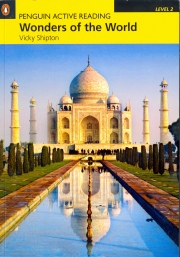Wonders of the World
reviewed by Neil Mc Beath, Oman

Wonders of the World.
Vicky Shipton 2010
Pearszon Longman pp. 44
ISBN 978-0-9978501-1-6
Many people remember where they were when they heard the news that Diana, Princess of Wales, had been killed, and EFL publishers have particular reason to remember that event. The same week saw the death of Mother Teresa of Calcutta, and at a stoke, two of the most obviously iconic figures for the “Do you recognize these famous people?” activities had gone. Coursebooks that had been intended to last for years suddenly needed an update.
The same is true of this book. It is a Level 2, 600 headword reader in the Penguin Active reading series, and it is a model of its kind. We are all too short of factual graded readers, particularly at the lower levels, where students’ maturity is often at odds with their linguistic competence. In this case, wee have a book that manages to both capture, and hold, the interest.
It is divided into six chapters, five of which are followed by a double page spread of activities. There is also an introductory page of activities (p. iv) which offers illustrations of low frequency lexis like canyon, temple and waterfall, and the book concludes with four pages of Talk about it (p. 40), Write about it (p. 41) and Project (pp. 42-44) ideas.
Visually, the book is extremely attractive. No fewer than 51 coloured photographs and drawings enliven the pages, including photos of lesser known wonders like Kansai Airport on its artificial island near Osaka (p. 19); the Lehsan Buddah in China (p. 17); and a vertiginous viewing platform that protrudes over the rim of the Grand Canyon (p. 35).
Many of the photographs, moreover, are stunningly beautiful. The rising sun illuminating the Akashi-Kaikyo bridge in Japan (p. 10), and the Millau Bridge soaring above the cloud-filled valley of the Tarn (p. 11) are simply unforgettable.
So where is the falw? Unfortunately, during the publication process, this book was overtaken by events. The Angel Falls (p. 36) in Venezuela have fallen victim to President Hugo Chavez’s anti-American sentiments, and they are now to be referred to by their Amerindian name – Kerepakupa Vena. Whether this change will last is anybody’s guess, but the ease of the Spanish version – Salto Angel – may be Chavez’s undoing.
What is certain, however, is that the half-completed Burj Dubai (p. 31) is now completed and that it has a new name. It is now called the Burj Khalifa in honour of the Prince President of the United Arab Emirates, and it has become the symbol of Dubai’s triumph over recession.
On these grounds, therefore, this book loses something of its impact, and that is a great pity.

Please check the CLIL: Content and Methodology for Secondary Teachers course at Pilgrims website.
Please check the CLIL Materials Development ( Advanced Level) course at Pilgrims website.


|